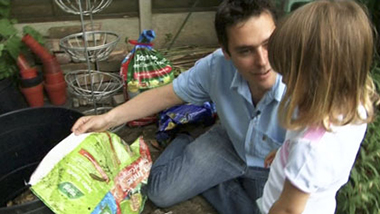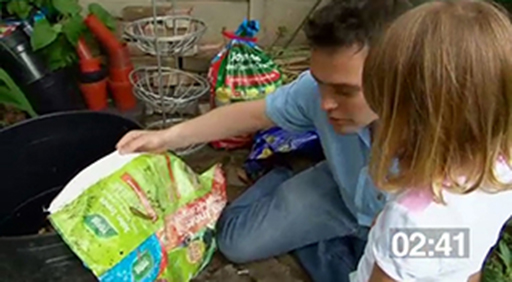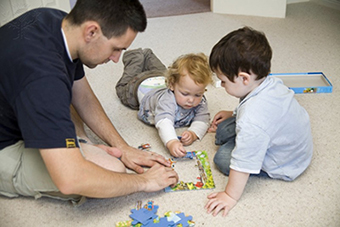2 Learning language and learning about the world
In this section, we are going to develop the argument that when we first learn to use language as infants we transform our understanding of language and of the world in general. In other words, we learn to use language, and through using language, we learn. This mutual reinforcement between learning language and learning more generally continues throughout our life in both formal and informal learning contexts. In this section, we will also set out the sociocultural linguistic approach (SCLA) to language learning and learning more generally. This is an approach which emphasises the inextricability of language and learning. Another feature that characterises this approach is its emphasis on learning through social interaction, in contrast to an exclusive focus of learning as a mental and cognitive process.

You will start to consider the relationship between language and learning by looking closely at an informal exchange between a young child, her father and her grandmother.
Activity 1

Transcript: Scarlett, father and grandmother
Watch the ‘Scarlett, father and grandmother’ video above. It shows Scarlett, aged two years and 11 months, talking to her father and grandmother in their garden in London, England. As you watch the unfolding interaction, note down the different types of learning you can observe. Provide an example of each. Consider, too, what role Scarlett’s family plays in the learning process. If you have already studied courses on language analysis, be as specific as you can about the language used.
| Aspect of language acquisition | Notes |
|---|---|
| Grammatical structures | |
| Vocabulary | |
| Pronunciation | |
| Interaction | |
| Acquiring knowledge |
Once you have written your notes, click on ‘Reveal discussion’ button below to read a commentary on the video clip. Please note that whereas you were requested to make notes, this is a more ‘polished’ commentary since it will form an important part of the teaching. There are many ways of responding to this activity, and your reply is unlikely to have made the same observations as the ones below.
Discussion
In the video, Scarlett is learning different aspects of the English language. For example, she is learning new vocabulary (‘beetle’, ‘slug’, etc.), and words she has previously learned (such as various colours and numbers) are carefully reinforced by her father and grandmother, including their correct pronunciation.
At the same time that Scarlett is learning language she is also learning something about the world. For example, she is learning (in a very rudimentary way) how to sort and classify the natural world. This includes learning how different types of insects (namely beetles and spiders) can be distinguished through different attributes (such as numbers of legs) and how slugs are different from snails through having (or not having) a shell. She is also learning to differentiate between leaves that are ‘alive’ and those that are dead. Such taxonomies are a fundamental resource in enabling Scarlett to begin ordering and categorising the world around her.
Scarlett is also learning how to interact with other human beings in order to exchange information and get things done. That is, she both listens and speaks to her family in an interactive process of ‘turn-taking’. Although she asks very few questions she finds out many new things when in response to her father’s questions she says, ‘I don’t know’. She can also give simple commands: ‘you come here’, ‘you put him down’, ‘don’t touch him’, in order to get people to do things for her.
Although in mature adult speech, commands are often expressed as either imperative clauses in which the subject (you) is absent – e.g. ‘come here’ – or expressed indirectly through interrogative clauses – e.g. ‘Could you come here?’ – Scarlett tends to use declaratives to make commands, which include the subject – ‘You come here’.
Did you notice how Scarlett’s father and grandmother use language structures first to facilitate cooperative interaction, using mood or question tags such as ‘isn’t it?’ and also to model causal relations, for instance ‘why are they …’ and ‘because they’re …’.
The clip shows that learning often occurs in social interaction. Although in other contexts this might well be peer interaction, here Scarlett is interacting with more expert adults who provide various kinds of support for her language and learning development; prompting, guiding and modelling, as appropriate. For example, Scarlett’s father, Dominic, asks her (while pointing to a slug), ‘Do you know what this is called?’ And then prompts her, ‘It begins with “s”’. He then provides the answer, ‘slug’. In many ways, then, Dominic is acting as an informal teacher for Scarlett’s development, with, in some cases, quite explicit teaching of both language and ‘content’.
This activity demonstrates the interdependency of language and learning. This inextricability between language and learning is a fundamental characteristic of the sociocultural linguistic approach (SCLA) to language and learning. Aside from emphasising the inextricability of language and learning, another feature of SCLA is its emphasis on learning through social interaction. In other words, according to this approach, learning can only take place through interaction with other human beings. This emphasis on interaction distinguishes this approach from other approaches to learning which pay more attention to the mental and cognitive processes of learning. In the next section, we will look at this in more detail and whether language and learning is a cognitive or social process.

